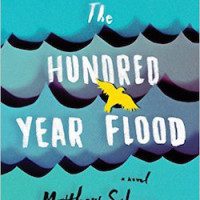We awake to the memory of floodwater. Tee, the protagonist of The Hundred-Year Flood, is in a rehabilitation facility in Boston. He has just come back from a sojourn in Prague, and flashes of a woman haunt him, water drowns him. A head injury conflates figures and events from his time abroad, and the story returns to us as it returns to him.
Tee is adrift after the death of his uncle and the further exposure of an affair between his father and aunt. He takes a sabbatical from college and goes to Prague, where “for thousands of years, private lives had withstood the oppression of empires,” to fortify and forget himself. There he meets a painter and his wife, Pavel and Katka, who ask him to model for a painting, the first of which shows him rising from the ground, ascendant. It’s not the only painting with Tee as the subject. The last shows him lifeless under water, just as the real water rises over Prague.
Under Communist rule, Pavel’s work served as a form of underground protest, with Katka as his conspirator and muse. The Velvet Revolution frees the country but also deprives Pavel of his purpose. When Tee arrives, the couple occupies a smoldering, unsteady present. Tee is drawn to their past and their intensity, and this leads to an affair of his own, with Katka.
There’s no shortage of well-placed parallels here. Tee follows his father’s pattern of adultery and abandonment. Katka’s father was abusive and depressive and eventually took his life. They both want to write themselves out of the world, and they get their opportunity when the rivers begin to swell.
Salesses handles the flood deftly. He calls just enough attention to it, and rather than indulging in the fantastic possibilities of putting Prague under water, he captures the scene with a few choice details. A building crumbles, animals from the zoo are airlifted to safety, police pound on doors to evacuate residents. Readers feel the water rise, its weight, the slow, dense swelling that creates an ominous and knowing pall, as if the natural forces in this story—this Prague—are purposely calling out Tee, delivering the message that he has wanted to avoid: you can’t hide from life. You must confront the large, painful questions about yourself or they will return and submerge you. That the flood occupies the last third or more of the book, with the action largely staying in Tee’s apartment, closes the reader in even more. The longer we spend in those couple of rooms, the more we wonder: how did we get here? How did his decision to go to Prague lead him to these chance encounters and deliberate infidelities and end up here, in this disaster?
A transplant not only to Prague but to the United States, Tee was born in Korea and brought to the US by his father. While abroad in a hospital, his father was present when Tee’s birth mother died shortly after labor, and he decided to adopt the child as a gesture of compassion. This is the story Tee has known, and the one that now falls under question as his parents separate while he is abroad. The family pulls apart, and what results are new revelations about how it first came together.
The love triangle, the epic backdrop, the questions about Tee’s birth—all of the elements are in place, and they offer plenty for readers to grasp and ponder. Yet the novel seems not to trust its own story. Metaphors are introduced and over-emphasized, as with Pavel’s comment about Tee opening a door for himself, which Tee struggles several times to understand, but which feels deliberate, like something we’re supposed to pay attention to. The same with Tee’s internal container a place within himself that he fills with things he wants to avoid saying or confronting—it isn’t a consistent part of his character and feels obligatory when mentioned. His great talent at drawing seems implanted as a way to overtly connect him with his father. Likewise, the novel weaves in the history and myth of Prague, as Katka recounts tales of heroes and saints and prophecies, but our attention is deliberately called to their importance. Tee fears losing “the stories that contextualized the city. He didn’t realize yet how much he needed them to contextualize him.” Or consider a climactic moment when he hangs from a statue that is, he reminds us, the patron saint of swimmers. The myths are compelling, but readers may wish they remained myths, contributing to the atmosphere and magic of the city without the loaded meaning.
The story feels heavy, and it should, given the important, weighty questions Tee struggles to answer about his uncle’s death, his birth mother, and his own home in the world. But readers may wish for a breath, for the narrative to lift in places. Salesses could trust us more to make connections, to let the exterior speak, to mean less overtly and ease the imposed weight on this story, which speaks richly for itself.
The Hundred-Year Flood is admirable for what it tackles, for the depth of its subject, for the risks it takes with structure, for the love triangle it quickly establishes and charges with tension, for the questions it raises about what we inherit from our parents, known or unknown, and how we ground ourselves when we’ve been living on top of lies and murky beginnings—on rising, threatening waters, you might say. It doesn’t need extra meaning or metaphors. Ultimately Tee’s journey, like most good journeys, comes back to where it began, to the story of his earliest origins. The waters recede and expose what has been covered, and what he most needs to see.





